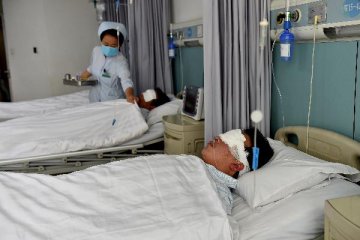
China is promising greater efforts to provide comprehensive medical care across the country through further medical reform that will benefit both urban and rural residents.
The State Council executive meeting chaired by Premier Li Keqiang on Wednesday approved two guidelines, one on improving health care and medical service and another on efforts to forge ahead medical reform, during the 13th Five-Year Plan period (2016-2020).
The new guideline on improving medical service and health care sets out that more efforts will be made in improving health care in the following aspects.
First, greater efforts will be made in major disease control and treatment. The government will make more efforts in better preventing major chronic diseases and illnesses such as hypertension, diabetes, stroke, as well as major contagious and mental diseases. The government will encourage more nursery training, especially in caring for the elderly, children and pay more attention to tackling mental disease.
Second, medical competence at the grassroots level is to be enhanced with more medical resources delivered to lower tier institutions. It also calls for improving treatment for the elderly, people with disabilities and poverty-stricken families. Third, approval procedures for new and urgently needed medicine will be simplified. Internet Plus health care will be more widely applied across the country to make medical services immediately reachable. More incentive will be provided to the needs of families with two children.
The guideline also emphasized developing the health industry while encouraging more social investment to the sector.
"It is important to encourage related departments and governments at all levels to take the initiative in implementation," he said, emphasizing that some obligatory targets in the guideline should be laid out based on sound evaluation.
Guideline in deepening China's medical reform in the coming five years was also approved on Wednesday. A set of measures will be implemented. Medical consultation through family doctors will be encouraged, and the government will pilot the ongoing hierarchical medical system in 85 percent of regions around China.
The guideline also encourages wider range of medical resource sharing. The government will give strict price control on medical equipment and medicines while better encourage medical services and consultations.
The guideline has set the goal that by 2017, reimbursement on hospitalization fee will be realized across different regions and provinces. More improvements will be made in the country's medicine supply system, and the government will ensure the supply of low-price medicine, children's medicine, as well as some urgently demanded medicine.
"In terms of medical reform, we need to concentrate on areas of people's concerns, and work harder in reducing high quality medical resources concentration in major cities, and make them more available to the public," Li said.
"The medical system needs to be lowered down, and administrative fragmentation needs to be broken to better serve public needs for medical service and cost reimbursement," Li stressed.
Health and medical care stays on top of the government's priority, as Premier Li pointed out in this year's government work report that "health is the root for people's happiness."
He has stressed on many occasions on the importance of medical reform. "We should continue to provide a sustainable healthcare system that matches our national conditions, so that all people can enjoy better medical service at lower cost," Li has said.
China has recorded impressive achievements in improving medical and health care in the past five years. Figures from the National Health and Family Planning Commission showed that average life expectancy in China reached 76.34 years old in 2015. Infant mortality rate decreased to 8.1 from 13.1 per 1,000 infants in 2010.




















Latest comments